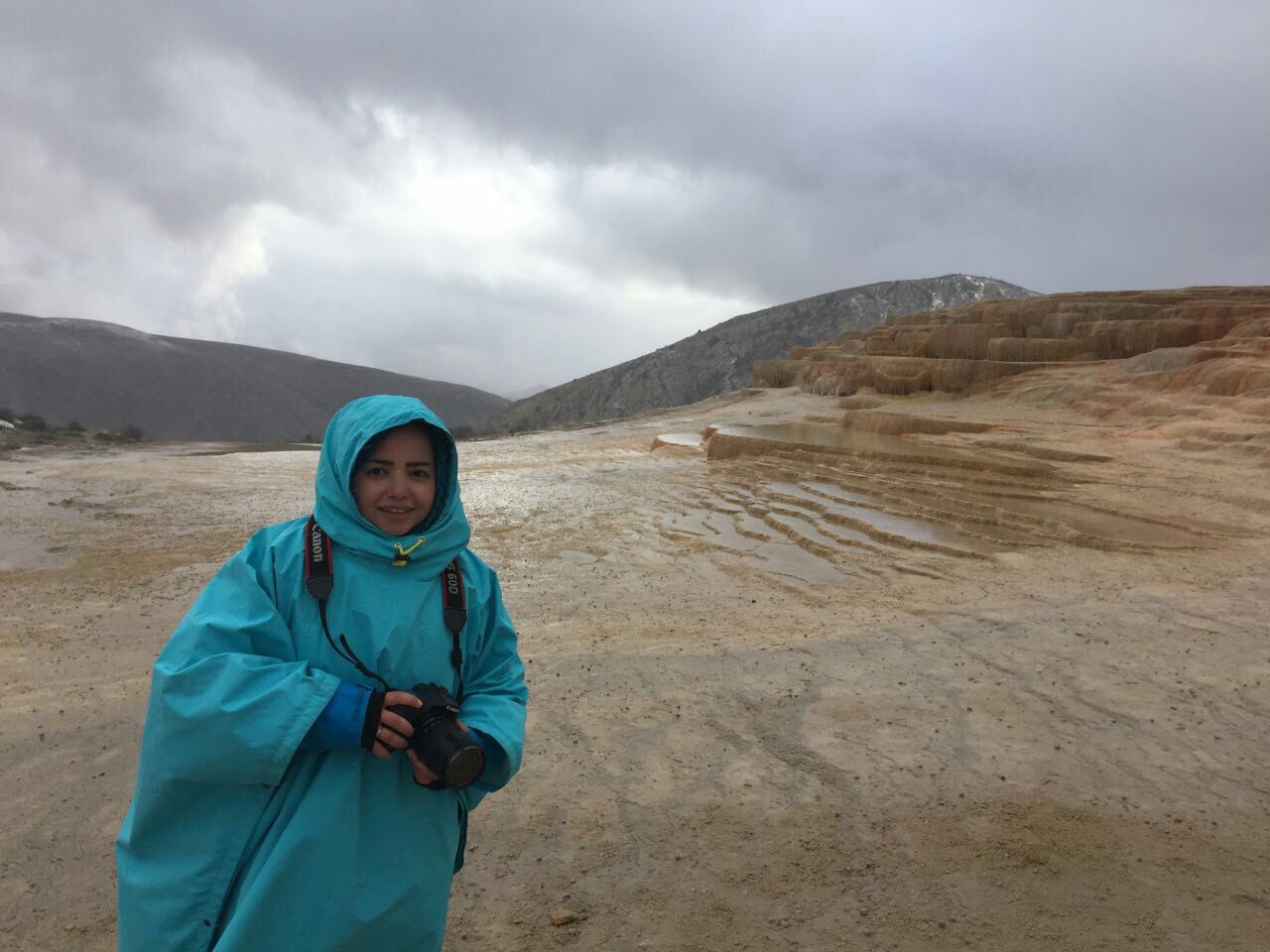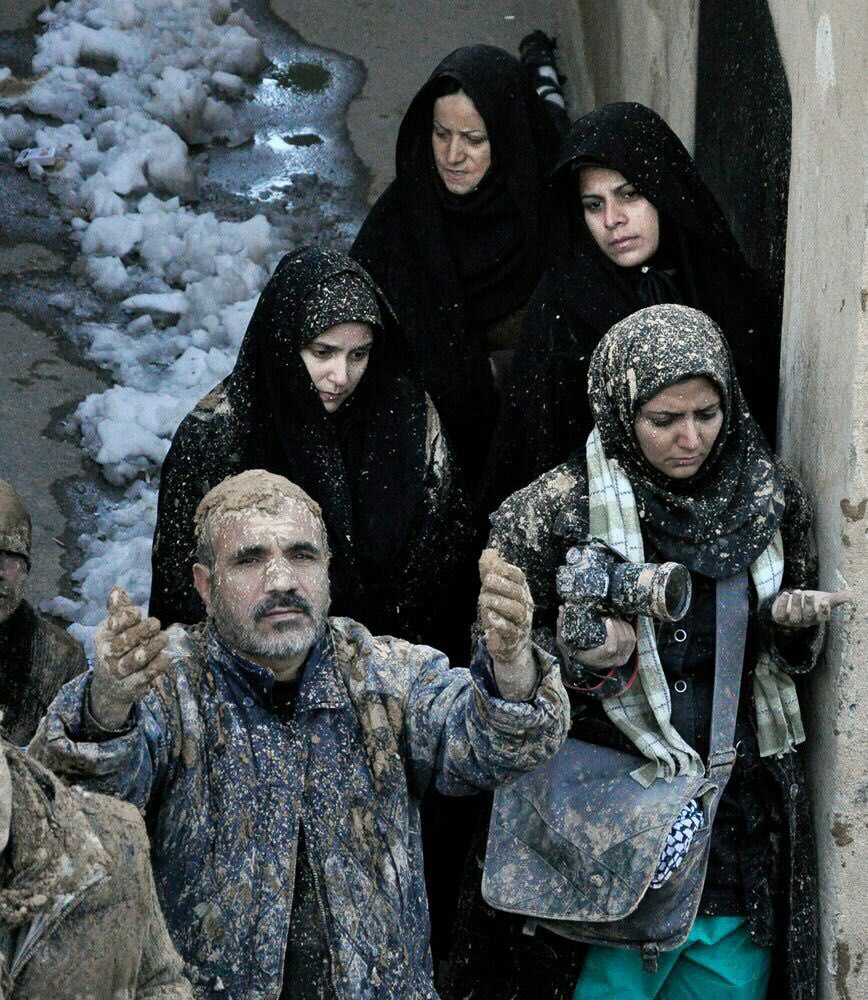س سهلا أن تكون المرأة صحفية في أماكن كثيرة، ولكن الأصعب أحيانا أن تقرر حمل الكاميرا بنفسها أو أن تعمل كمصورة في الميدان.. واقع لا يمكن تجاوزه في كثير من البلدان وفي عدد من المجتمعات، وهذه المعادلة قد تكون نسبية في بلد كإيران، البلد الذي استطاعت مصوراته أن يقفن خلف العدسات منذ عقود طويلة، وقد هيأت لهن الظروف الاجتماعية والتاريخية فرصة التقدم في هذا المجال.
يستطيع أي صحفي قادم من خارج إيران أو يعيش داخلها، أن يلاحظ تواجد المصورات وبكثرة في أي تغطية خبرية، إما للتصوير الفوتوغرافي أو الفيديو.. كثيرات احترفن التصوير بالحصول على شهادات من معاهد فنية، إلى جانب الدراسة في كليات قد لا تمت إلى الصحافة أو الفنون بصلة.. وكثيرات أيضا يفضلن التخصص في التصوير الوثائقي، حالهن كحال مصورات استطعن الوقوف خلف العدسة قبل عقود، فإيران بلد كبير وفيه من القصص والحكايا الاجتماعية الكثير، وهو ما يمكن للصورة أن تنقل تفاصيله وجمالياته.
بداية الحكاية
عمر فن التصوير الفوتوغرافي في إيران يزيد عن 160 عاما، فقد دخلت كاميرات التصوير إليها قادمة من بريطانيا العظمى وروسيا، وحملها مستشارون وعسكريون أوروبيون كانوا يترددون مرارا على طهران.. وصلت أولاها في عهد محمد شاه، ملك القاجاريين الذي حكم البلاد بين عامي 1834 و1848، ليزيد عددها أكثر في عهد خلفه ناصر الدين شاه، الذي فتن بالتصوير حين كان في باريس، وأحضر العدة بنفسه إلى إيران، واحترف التصوير وطباعة الصور، بل وقدم مجموعة صور للملكة الأم وللحريم في قصره الملكي من الأميرات والجاريات، لتظهر المرأة للمرة الأولى أمام الكاميرا في عهده، ولتقف خلف عدستها لتلتقط الصور بنفسها بعد ذلك.
عِزت الملوك -الملقبة بأشرف السلطنة- هي أولى المصورات الإيرانيات، وكانت من الحاشية الملكية في العصر القاجاري، وتعلمت التصوير من الأمير محمد ميرزا، وجلست أمام الكاميرا بعد أن حصلت على الإذن من ابنة ناصر الدين شاه المسماة تاج السلطنة، وصُورهن موجودة حتى اليوم في قصر غلستان بطهران.
سيدات الطبقة المرفهة هنّ من جلسن أمام الكاميرات أولا، في وقت لم تقدر كثيرات على فعل الأمر ذاته إن كان المصور رجلا، ففتح هذا الأمر الفرصة لتتعلم نساء أخريات التصوير على يد آبائهن أو أزواجهن من المصورين، ومنهن أمينة زمان وعزيزة جان، بنات المصور ميرزا حسن خان، حيث بدأن التصوير في سن الحادية عشرة، وهنّ من المنطقة التي تسمى اليوم محافظة فارس الواقعة جنوبي إيران. وعملت مانيا بجاميان مع زوجها في تبريز إبان العهد القاجاري أيضا، وأصبحت طاهرة مملكتي زوجة ما شاء الله غنجوي خان، أول من التقطت صورا فورية، وأدارت بنفسها في كرمان أول أستديو تصوير افتتحته عام 1931. ومع مرور الوقت أخذ التصوير الفوتوغرافي في إيران طابعا توثيقيا، لتنقل صور ذاك الزمان شكل الواقع الاجتماعي، وهو ما جعل بعضهن يلتقط صورا توصف اليوم بالوثائقية.
إبان الحرب العالمية الثانية فتحت أبواب البلاد أكثر أمام الأجانب، فحملت ستينيات القرن الماضي التغيير الذي أدخل الإيرانيات عالمَ التصوير الصحفي بشكل حقيقي، بعد أن كان يقتصر على تصوير العائلات والمناظر الطبيعية وجوانب الحياة الاجتماعية، وأصبحت سودابه قاسملو أول مصورة صحفية إيرانية زودت الصحف المحلية بصورها. وتعلمت الإيرانيات خلال السبعينيات في كليات الفنون التي افتتحت في طهران، وبات التصوير الخبري والصحفي متاحا لكثيرات، وليس فقط لمن تبناهن أحد المصورين المعروفين.
تحولات الثورة
أثرت الثورة الإسلامية الإيرانية التي خلعت الشاه البهلوي عام 1979 على كل جوانب الحياة، لكن تفاصيل الحراك انعكس إيجابا على التصوير الفوتوغرافي الصحفي بالذات، فأصبح التصوير التوثيقي مهما لكل من امتلك كاميرا في منزله، وتحيّن المصورون والمصورات الفرصة في الشارع ليوثقوا كل لحظاتها، وسطع نجم هنغامه جلالي ورعنا جوادي خلال تلك الفترة، وطبعت أعمالهما في صحف ومجلات كثيرة. ومع أن انتصار الثورة أثر سلبا على الفنون عامة لسنوات بسيطة، فإنه تم افتتاح عدد من الجامعات التخصصية بعدها، ودشن الفنانون نقابات واتحادات ومدارس خاصة بفن التصوير، فوصل التصوير الصحفي بالذات الذي هيأت له الثورة أرضية قوية إلى ذروته في سنوات لاحقة، واحتلت المرأة مكانة هامة فيه رغم أن الصعوبات تُعقِّد عليها مهامها كما تقول بعضهن.
تحديات ومحددات
يوجد في إيران اليوم قرابة 72 ألف وكالة وموقع إخباري بحسب وزارة الثقافة والإرشاد، فيها العديد من المصورات اللاتي يقفن جنبا إلى جنب مع زملائهن الرجال، وتختلف المهام الموزعة بينهم بحسب مكانها وصعوباتها.
تقول مصورة وكالة "مهر" للأنباء ليلا قدرت اللهي إنها احترفت التصوير منذ خمس سنوات، وعملت مع شبكة "سي.أن.أن" الأميركية ووكالتي فارس ومهر الإيرانيتين، وهما من أهم الوكالات المعتمدة محليا، وتعتبر أن التصوير الصحفي له قواعد صارمة تعتمد على تعلم أسس وقواعد التصوير الفوتوغرافي، وهذا ما يساعد أيضا على احتراف التصوير الوثائقي الذي تركز عليه أكثر في الوقت الراهن، حتى خلال عملها مع الوكالة.
ترى قدرت اللهيأنه رغم كل ما حققته المصورة الإيرانية، فلا تزال هناك مسافة بينها وبين الرجل الذي يعمل في ذات المجال، وتقول إن المجتمع الإيراني في بعض المناطق لم يتقبل بعدُ وجود امرأة مصورة تغطي مراسمهم أو الأحداث التي تجري قريبا منهم. وتضيف أن عدد المصورات أقل مما يجب أن يكون عليه، وتعزو الأمر إلى عدم دعم هذه المهنة، ووجود صعوبات عديدة تجعل كثيرات يبتعدن عن الساحة الصحفية والعمل بشكل منفرد، لا مع وكالات ومواقع إخبارية.
مع ذلك، تصف قدرت اللهي التصوير الصحفي بالممتع، حتى وإن كان خطيرا في بعض الأحيان، وتتقاطع معها مصورة صحيفة "اعتماد" الإصلاحية صبا طاهريان، التي ترى أن الصعوبات التي تواجه المرأة المصورة هي ذاتها التي تواجه النساء الإيرانيات في حياتهن اليومية.
وتذكر طاهريان أن المصورين الرجال يستطيعون التجول في الشوارع حتى في أوقات متأخرة، والتقاط صور من أي مكان حتى إن لم يكن آمنا، وحتى إن كانوا يحملون كاميرات باهظة الثمن، وهو ما قد يعرضهم أحيانا للسرقة، لكن الأمر ليس سيان بالنسبة للنساء، حيث سيكون الأمر أخطر عليهن، خاصة إن كانت المصورة لوحدها.
ترى طاهريان أن المحددات التي تخلقها الأعراف في بعض المناطق قد تعقّد عمل المصورات أكثر من بعض القوانين الرسمية. فقبل سبع سنوات، كان عليها تصوير مراسم "بير شاليار" الكردية في إحدى قرى محافظة كردستان.. تقول إن النظرات نحوها كانت تعقّد العمل، ومع ذلك اقتربت والتقطت صورها، ليصبح الأمر في الوقت الراهن عاديا بالنسبة لأهالي تلك القرية، حيث تذهب عديدات لتصوير ذات المراسم كل عام.
تتمنى طاهريان أن تلتقط صورا صحفية لأي مكان تريده، وأحيانا يكون الحلم صعبا، فقد استطاعت أن تدخل ملعب آزادي لكرة القدم مرة واحدة خلال حياتها المهنية، لأن دخول الإيرانيات للملاعب ممنوع، وهي التي ذهبت لتصوير جنازة انطلقت من هناك للاعب والمدرب الإيراني المعروف ناصر حجازي.. تقول إنها تتمنى أن تلتقط صور المباريات والجمهور الذي يشجع فريقه ويغضب من فوز الفريق الآخر، وترى أن الطريق ما زال طويلا لتكتمل تجربة المرأة المصورة في إيران.
ورغم وجود كثيرات منهن يعملن خلال التغطيات الصحفية الداخلية المتنوعة، فإن عدد المصورات ممن يغطين مناطق الحروب في الخارج شحيح، ومع ذلك لم يَغبن عن هذا الميدان، وإحداهن مهدية مير حبيبي المولودة عام 1982، فهي مصورة شابة كتبت قصتها في إحدى الصحف الإيرانية، حيث بدأت العمل لكسب قوتها في سن صغيرة بعد أن خسرت والدتها ومن بعدها أختها.. تعلمت التصوير خلال عملها في أحد الأستديوهات، وقررت أن تقترب أكثر من الناس وقصصهم، وخاصة أولئك الذين يحيط بهم الموت، كما أحاط بها منذ نعومة أظفارها.. لم تجد من يدعمها أو يرسلها في مهمة رسمية لتغطية مناطق الحروب، فقررت أن تؤرخ ما يحدث في صور فوتوغرافية كانت السبب في شهرتها رغم الصعوبات.. أفغانستان كانت محطتها الأولى، وهي التي لم تعتد صوت القذائف ولا رائحة البارود، تردد على مسمعها جملة "ما الذي تفعله فتاة هنا؟" أكثر من مرة، التقطت صورا لتفجيرات وأرسلتها إلى وكالات لم تتردد في نشرها، وعادت لزيارة أفغانستان مجددا لتكمل مجموعتها الصورية، ومن بعدها ذهبت إلى الصومال وإلى سوريا التي دخلتها من الحدود التركية رغم التحديات.
تعمل إيرانيات أخريات لصالح وكالات وتلفزيونات أجنبية، ويقمن بتصوير الفيديو، ويعملن أيضا في هيئة الإذاعة والتلفزيون، لكن قليلات فقط يقفن خلف عدسات كاميرات البث المباشر.
فازت المصورات الإيرانيات بجوائز عديدة وخاصة مصورات الفوتوغراف، منهن زهرة صابري التي حصلت على جائزة صور الصحافة العالمية، فنالت الجائزة الثالثة عن فئة صور الحياة اليومية العام الماضي، وهي التي تعمل أيضا لصالح وكالة مهر للأنباء. وتم اختيار مجموعة سهيلا صنم نو مؤخرا لتكون واحدة من بين عشر مصورات ستعرض أعمالهن الفوتوغرافية في عدة دول، من قبل المؤسسة المشرفة على الجائزة الدولية للمصورات ومقرها في فرنسا.
في إيران نفسها، أقيم معرض جماعي بمشاركة 17 مصورة صحفية تحت عنوان "الفصل الثامن"، وهو الذي يقدم رؤيتهن للهوية النسوية وللمساواة. وقبل أشهر قليلة أقام المصور أمير حسين حشمتي معرضا ضم أبرز أعمال 26 مصورة إيرانية من ثلاثة أجيال.. كل هذا الاهتمام ما زال محفوفا بالكثير مما قد يُعقد أحلام عديدات.
مصورات إيرانيات ونماذج من أعمالهن...











































